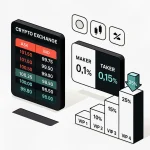The real estate market is notorious for high minimums, illiquidity, and friction. Today, a quiet revolution is reshaping how properties are financed, owned, and traded: blockchain-based tokenization. If you’ve heard the phrase “Blockchain and Real Estate: Tokenizing Property” and wondered how it works in practice, this guide explains the mechanics, compliance realities, benefits, risks, and how to get started—without the hype.
Quick note: This article is educational, not financial or legal advice. Always consult qualified professionals before investing.
What tokenization really means (beyond the buzzwords)
“Tokenizing property” doesn’t typically mean the deed itself lives on-chain. In most jurisdictions, land title still sits with a county recorder or a national land registry. What tokenization does, in a legally durable way, is represent ownership or economic rights to a property through securities issued by a legal entity (usually an SPV—special purpose vehicle) that owns the property.
Two primary models:
- SPV equity or debt tokens: The SPV holds the property. Investors hold tokens that represent shares or notes of the SPV. Tokens are digital securities governed by securities laws.
- Revenue-sharing tokens: Structured to distribute a portion of net rent or project income. Still usually treated as securities.
In both cases, on-chain tokens are a registry of investor rights with programmable rules (transfer restrictions, lockups), while the legal agreements define those rights off-chain.
Why investors and issuers care now
- Lower minimums and fractional access: Investors can participate with smaller checks than typical private deals.
- Faster settlement and compliant transfers: Automated transfer restrictions reduce manual legal friction.
- Secondary market potential: Regulated venues enable trading, helping address real estate’s liquidity challenge.
- Real-time distributions: Rent and yields can be paid in stablecoins with on-chain transparency.
- Global reach with compliance controls: KYC/AML and jurisdictional restrictions are embedded into token logic.
The workflow: From building to blockchain
1) Deal formation and SPV setup
– Sponsor forms an SPV (LLC/Ltd). Operating agreements specify investor rights, governance, and distributions. Title remains with the SPV.
2) Compliance foundation
– Jurisdictional analysis: Are you in the US, EU, Singapore, UAE, Switzerland, etc.? Each has a different regime for digital securities.
– KYC/AML and investor accreditation: Platforms verify identity and eligibility.
– Offering exemptions or prospectus: In the US, Reg D/Reg S/Reg CF/Reg A+; in the EU, prospectus exemptions and MiFID II alignment; MiCA, where applicable, governs certain crypto-asset providers.
3) Token standard and issuance
– Security token standards like ERC-1400/ERC-3643 (Ethereum-compatible) support partitioned ownership, transfer restrictions, and compliance checks.
– Tokens are minted to whitelisted wallets after successful KYC/AML.
4) Asset servicing and data
– Corporate actions: distributions, votes, and disclosures can be executed and recorded on-chain.
– Stablecoin rails: USDC/USDT for rent distributions improve speed and traceability.
– Oracles and reporting: Off-chain property data (appraisals, rent rolls) are attested and shared; valuation remains a hybrid process.
5) Secondary trading
– After lockups, tokens can be listed on Alternative Trading Systems (ATS) or Multilateral Trading Facilities (MTF) that support digital securities, subject to jurisdictional rules.
What you actually own
- Equity tokens: claim on SPV’s residual cash flows and appreciation; governance rights per operating agreement.
- Debt tokens: fixed income with priority in payout waterfalls; typically no equity upside, but clearer seniority.
- Income-share tokens: distributions tied to net operating income or revenue, with detailed rules on expenses and reserves.
Always read the offering documents: operating agreement, PPM or prospectus, subscription agreements, and token terms. The token alone does not tell the whole legal story.
Benefits, with nuance
- Liquidity (conditional): Secondary markets are not automatic. Liquidity depends on deal quality, investor interest, and venue availability.
- Price discovery: On-chain order books can aid transparency but may be thin for niche assets.
- Efficiency: Programmed compliance and cap table management reduce transfer-agent overhead.
- Global reach: Wider potential investor base with automated geographic restrictions.
- Faster distributions: Near-instant stablecoin payouts reduce admin time and payment friction.
Real-world examples you may encounter
- Fractional rental properties tokenized via SPVs with low minimums and monthly stablecoin distributions.
- Tokenized commercial buildings with regulated secondary listings after a lockup period.
- Fund-style structures: pooled tokenized vehicles with diversified property exposure.
Note: Platforms differ on chain choice (Ethereum, Polygon, Gnosis, Avalanche, Algorand, etc.), custody (self-custody vs. broker-dealer custody), and compliance integrations. Evaluate each one independently.
Risks and constraints to understand
- Regulatory risk: Rules evolve. Securities regulators continue to refine guidance on digital assets.
- Title and enforcement: The legal wrapper (SPV, agreements) is what courts enforce, not just the token.
- Valuation and data integrity: Appraisals, rent rolls, and expenses are off-chain; quality of reporting matters.
- Counterparty and operational risks: Sponsor quality, property management, maintenance reserves, and insurance are critical.
- Smart contract risk: Token standards are mature, but implementation errors and key management remain non-trivial.
- Liquidity illusion: Secondary markets can be thin. Don’t assume quick exits.
- Tax complexity: Dividends vs. interest vs. passthrough K-1s can affect tax outcomes.
Regulatory snapshot (select jurisdictions)
- United States: Most tokenized real estate falls under securities laws. Common routes include Reg D (accredited investors) and Reg S (offshore). Secondary trading often occurs on ATS. Transfer restrictions and holding periods apply.
- European Union: Tokenized real estate generally treated as financial instruments under MiFID II; trading venues must be authorized. MiCA governs certain crypto services but does not replace securities law.
- Switzerland, Singapore, UAE: Progressive frameworks for digital securities with clear licensing pathways for issuance and trading. Still requires strict AML/KYC and disclosures.
Always verify the license status of the issuer, broker-dealer, ATS/MTF, and any custodian.
The tech stack under the hood
- Chains: Ethereum mainnet for security and network effects; L2s/sidechains (e.g., Polygon, Gnosis) for lower fees; institutional or permissioned chains in some jurisdictions.
- Token standards: ERC-1400/1410 and ERC-3643 (T-REX) support partitions, checkpoints, and identity-based compliance; ERC-1155 may appear in some designs.
- Identity and compliance: Whitelists, verifiable credentials, and transfer restrictions (rule-driven smart contracts).
- Corporate actions: On-chain voting, distribution schedules, and event logs for auditability.
- Custody: Self-custody with hardware wallets, qualified custodians, or broker-controlled wallets; each carries different risk and convenience profiles.
Structuring the deal: economics and governance
- Equity vs. debt vs. hybrid: Choose based on risk tolerance, desired cash flows, and capital stack position.
- Waterfalls and reserves: Understand expense priorities, maintenance reserves, debt covenants, and distribution triggers.
- Token supply mechanics: Fixed supply vs. capital calls and redemptions; effects on dilution and NAV alignment.
- Lockups and transfer rules: Programmed compliance, holding periods, and jurisdictional flags baked into smart contracts.
- Reporting cadence: Monthly rent reports, quarterly financials, annual audits—prefer independently verified data.
Secondary markets and liquidity design
- Listing requirements: Only compliant tokens with eligible investors can trade on regulated venues.
- Market making: Some platforms seed initial liquidity; understand spreads and volume.
- NAV alignment: Periodic appraisals help tether secondary prices to fundamentals—but expect deviations.
Due diligence checklist (practical and non-exhaustive)
- Sponsor: Track record, property management experience, prior exits.
- Legal: SPV documents, offering exemptions, transfer restrictions, venue licensing.
- Property: Location comps, cap rate assumptions, vacancy sensitivity, maintenance capex plan.
- Financials: Debt terms, DSCR, interest rate hedges, reserve policy, fee stack to the sponsor.
- Token mechanics: Standard used, whitelisting process, custody model, auditability.
- Disclosures: Frequency, third-party audits, valuation methodology.
- Exit: Lockup period, eligible secondary venues, buyback/redemption options.
Taxes and accounting
- Equity tokens: Distributions may be dividends or passthrough income (e.g., K-1 in the US). Clarify tax forms.
- Debt tokens: Typically interest income; withholding rules may apply to non-residents.
- Basis and capital gains: Token transfers are taxable events in many jurisdictions. Keep meticulous records.
- Stablecoin payouts: Track FX implications if your base currency differs from the stablecoin.
Consult a tax professional familiar with digital assets and private real estate.
Getting started as an investor: practical steps
1) Identify a compliant platform that offers “Blockchain and Real Estate: Tokenizing Property” opportunities aligned to your jurisdiction and risk profile.
2) Complete KYC/AML and wallet setup. Decide between self-custody and platform custody.
3) Acquire stablecoins (commonly USDC/USDT) for subscriptions and to receive distributions.
4) Subscribe to the offering and review the on-chain receipt of tokens in your whitelisted wallet.
5) Track performance, monitor disclosures, and plan for liquidity per lockups and venue options.
A helpful on-ramp for funding your wallet
If you need a reliable exchange to buy USDC/USDT or other crypto used in tokenized real estate subscriptions, consider creating an account with Bybit. Use referral code CRYPTONEWER during signup for a 20% trading fee discount and up to $30,050 in promotional benefits, subject to Bybit’s terms.
- Sign up: Click Bybit Sign-Up with CRYPTONEWER
- Enter referral code: CRYPTONEWER
- Benefit: 20% fee discount, plus up to $30,050 in rewards
- Next: Purchase USDC/USDT or the assets your chosen platform supports
Note: Exchange availability and features vary by region. Ensure compliance with your local laws.
Common myths, debunked
- “Tokens replace lawyers.” False. Legal documents and regulated intermediaries remain essential.
- “Instant liquidity is guaranteed.” Not in private real estate. Liquidity improves, but it’s still market-dependent.
- “On-chain deed means instant transfer of property.” Most jurisdictions don’t recognize deeds on public chains yet. The SPV wrapper is the enforceable layer.
- “All tokenized deals are the same.” Structures vary widely—read the documents.
Selecting the right platform or issuer
- Licensing: Is the issuer licensed where required? Are trading venues authorized (ATS/MTF)?
- Transparency: Do you get audited financials and third-party property data?
- Fees: Understand sponsor promotes, management fees, and platform fees.
- Tech and custody: Which chain, what token standard, and how are corporate actions executed?
- Investor support: Quality of documentation, reporting dashboards, and wallet recovery options.
Signals of maturity to watch
- Integration with mainstream custodians and brokers.
- Standardized digital security frameworks (e.g., widespread ERC-3643 adoption).
- Better oracles and data attestation for property metrics.
- Regulated secondary markets with meaningful depth and tighter spreads.
- Institutional participation in both equity and credit structures.
A glossary for quick reference
- SPV: Special Purpose Vehicle that holds the property asset.
- Digital Security (Security Token): A regulated instrument recorded on-chain representing ownership or debt.
- KYC/AML: Know-Your-Customer/Anti-Money Laundering compliance checks.
- ERC-1400/3643: Token standards for compliant digital securities.
- ATS/MTF: Regulated trading venues for securities in the US/EU respectively.
- Stablecoin: Token pegged to a fiat currency (e.g., USDC), useful for distributions and settlements.
Resources to go deeper
- Ethereum EIPs for digital securities: search “ERC-1400” and “ERC-3643” for technical specs.
- Securities regulators: SEC, ESMA, MAS, FINMA, FSRA—check jurisdictional guidance.
- Custody best practices: Hardware wallets, multi-sig, and qualified custodians.
- Industry research on RWA tokenization: Many top consultancies and analytics firms publish periodic market maps and frameworks.
Special offer reminder
Ready to fund your first tokenized investment? Create your account at Bybit with referral code CRYPTONEWER for a 20% trading fee discount and up to $30,050 in benefits. Acquire the stablecoins you need, then proceed to your chosen compliant real estate tokenization platform.





